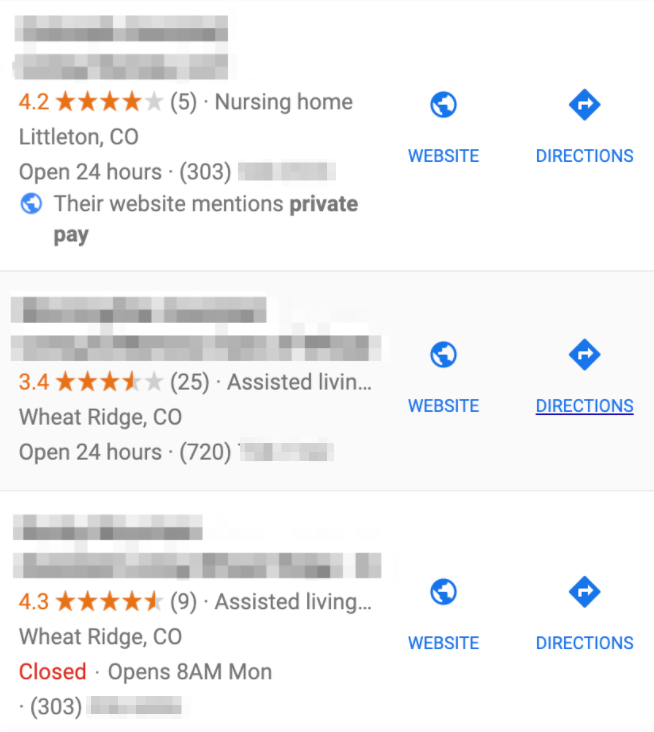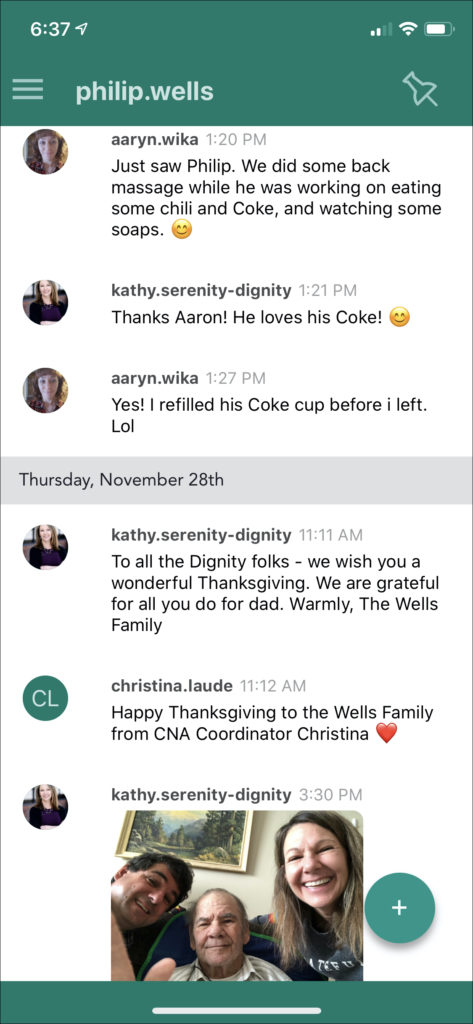Senior Living Providers: Elevate Your Reputation With One Simple Change
 When did you last buy something that had a 2.5-star review? Or dine at a restaurant your neighbor described as bland and overpriced?
When did you last buy something that had a 2.5-star review? Or dine at a restaurant your neighbor described as bland and overpriced?
Rarely, if ever, I imagine.
The same is true when people search for senior living. 83% of the time, a family member is doing the research when it comes to every area of residential care except Independent Living. We also know that family members are either heavy influencers or decision-makers in the selection process.
Today, anyone can get a quick read on your community’s reputation with a few words typed or spoken into a smart phone.
In that split second, the decision will be made whether to contact your community or not.
Here is a real-life example of a quick google search for ‘private pay assisted living near me.’
Notice there are 25 reviews for the lowest rated community, and far fewer for the higher rated communities?
It is highly likely that the community with a 3.4 rating compared to the others will be immediately eliminated as an option.

Reputation is everything when attracting new residents, and it comes in the form of:
- Word-of-mouth reputation
- Online reviews on various websites
- Content on your website
In the midst of COVID-19, you are fighting two battles: low occupancy and family members are nervous about moving their loved ones into residential care right now.
Fighting Negativity Bias
How can you develop enthusiastic evangelists, who will go out of their way to tell others about their incredible experience of your community?
How can you reduce the detractors, the people who actively share a bad experience with your community?
How can you reward your existing enthusiastic evangelists so they do more of it?

Negativity bias research shows that it takes 4-5 good things to overcome one negative.
Let’s say you are looking at a new sofa. The sofa has five reviews online, one negative and four positive. Negativity bias says you are most likely to negate the one poor review and chalk it up to someone having a bad day because there are four positive reviews that outweigh it.
What if the sofa has two negative reviews and three positive reviews? Did your decision become more difficult? Negativity bias research says yes.
You are 42% more likely to move on to another sofa that doesn’t have this positive-negative asymmetry.
Selecting a sofa and selecting a place to care for someone you love deeply are two completely different things. Emotions run high when someone’s loved one’s well-being is at stake.
That means you have to work twice as hard to build and maintain your reputation.
How can you do that?
One Simple Change
Tell the primary family member something good about their loved one 3-5 times each week.
That’s it.
It doesn’t have to be long. It doesn’t have to be earth-shattering. In fact, it’s the little things that matter most to family on a regular basis.
It can be as simple as this:

“Your mom sat down at the piano today as if she’d been playing it her whole life. Thought you’d enjoy this picture!”
“Your dad really loved his burger tonight! He asked me to thank the chef for him, so we brought the chef over and your dad shook his hand. It was very sweet.”
“Your wife joined in with the choir tonight as we sang Christmas Carols. She has a beautiful voice!”
BONUS POINTS if you included a quick photo of the event.
Here’s the reality…
>>> If you don’t share information regularly, the lack of information will assuredly work against you. <<<
When there is an information void, it will be filled. What it is filled with is your job to manage. Fill it with heart-warming, caring information to avoid the negative bias that plagues us humans.
Not only will the families love you, but so will your valuable and precious workforce. Oh, and by the way, it also makes it easy to comply with the new CMS Guidelines regarding communication to family!
4 Reasons Other Communities Don’t Do This, And How You Can Leapfrog Them
1. TIME
MYTH: “Our care team is too busy to do this.”
REALITY: What is the last text you sent? How long did it take you to send it? Say, 30-seconds? Or maybe less if you used voice-to-text.
2. RESOURCES
MYTH: “Who would be responsible for doing this? It can’t be the primary caregivers because we don’t know what they’d say or how. And our higher level staff doesn’t have time.”
REALITY: A quick, easy approval process eliminates this issue, freeing up nearly anyone on your staff to take point on communicating with families. That said, Activities Directors, Social Workers, and Marketing staff love to share great stories with families.
3. IT WILL OPEN THE FLOODGATES
MYTH: “If we start doing this, family will expect a lot more. What if we can’t keep it up? Or high maintenance family members will want updates multiple times a day. That’s just not possible.”
REALITY: The exact opposite is true! Over and over, we see high-maintenance – even litigious – family members turn into raving fans when they have someone who is sharing a picture of their loved one’s day on a regular basis.
4. LIABILITY
MYTH: “Too much communication puts us at risk of getting sued. It’s a balancing act, and we aren’t hiding anything, but we need to moderate what, when, and how much we say to families or our legal team will be all over us.”
REALITY: Studies show that most lawsuits begin in the first 14-days of residence due to poor or lack of communication. During this time, family is questioning whether they did the right thing, and if they selected the right community. Think of it this way, if you make small, regular deposits into the family’s ‘emotional bank account,’ when the inevitable difficult conversations arise, the family is far more likely to work with you to solve the problem than to place blame.
It’s a simple solution to a complex problem, which is often the best kind of solution! Other communities are still sending out mass communications and posting photos on Instagram or Facebook. What they don’t realize is that family doesn’t want to sift through a bunch of pictures to find their own loved one. They want to communicate with you about their loved, not about the community as a whole.
Using a HIPAA-compliant messaging platform like Serenity Engage will create raving fans out of family members, mitigate liability, increase accountability, and give you complete oversight into all communications between staff and family members.

We work with forward-thinking communities across the nation. Want to see if we’re a good fit for your community?

